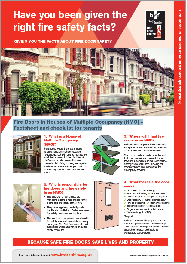- Home
- About BWF Fire Door Alliance
- Fire Door Safety
- Third-Party Certification
- Publications
- News
- Knowledge Centre
 Two new factsheets for tenants in privately rented flats, apartments, bedsits, hostels and Houses of Multiple Occupancy (HMOs) are published this week in a bid to increase both landlords’ and residents’ knowledge and understanding of fire door safety.
Two new factsheets for tenants in privately rented flats, apartments, bedsits, hostels and Houses of Multiple Occupancy (HMOs) are published this week in a bid to increase both landlords’ and residents’ knowledge and understanding of fire door safety.
The ‘10 Top Tips for Fire Doors in Flats’ is a one page infographic, full of advice on how fire doors work, where you can find them in a building, and the key things to look out for that could give an early warning of fire safety failings in a block of apartments or a converted house.
The ‘Fire Doors in HMOs’ factsheet gives similar advice, but also more information on other fire safety checks that tenants can do to reduce the risk of fire in the first place.
The practical guidance has been launched during Fire Door Safety Week by the BWF-Certifire scheme in the wake of worrying research that shows 65% of tenants in flats and apartments renting privately have not had any fire safety reassurance from their landlord since the Grenfell Tower fire. Unsurprisingly, a quarter of tenants renting privately feel more anxious about living in their home since the Grenfell Tower fire, and 28% of them do not trust their landlord to understand and implement all the necessary fire safety measures in their building, including 8% who do not trust them due to something they have specifically witnessed while renting.
Other research indicates that certain types of HMOs present significantly greater health and safety risks to tenants than comparable single occupancy dwellings. Risk assessments carried out by ENTEC on fire safety in HMOs concluded that in all houses converted into bedsits, the annual risk of death per person is 1 in 50,000 (six times higher than in comparable single occupancy houses). In the case of bedsit houses comprising three or more storeys the risk is 1 in 18,600 (16 times higher than in comparable single occupancy houses).
“Landlords can use these free resources to rebuild trust and communicate critically important fire safety messages to their tenants, and tenants can now take action if they have concerns,” says Hannah Mansell, spokesperson for Fire Door Safety Week. “Fire doors play a key role in passive fire protection, but their importance is often overlooked. These resources will arm landlords and tenants with the information they need to tackle any fire door problems in a building. At a time when fire safety is under such scrutiny, no one can afford to make any mistakes.”
Fire Door Safety Week, a national campaign now in its fifth year, is run by the British Woodworking Federation (BWF) , the BWF-Certifire Scheme and the Fire Door Inspection Scheme (FDIS), in partnership with the Government’s Fire Kills campaign. It aims to raise awareness about the role of fire doors in preventing life changing injuries and the legal responsibilities of managing fire door safety. Both fire door guides are available as free downloads on the Fire Door Safety Week toolkit. www.firedoorsafetyweek.co.uk
ENDS